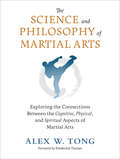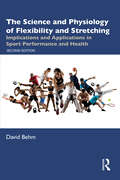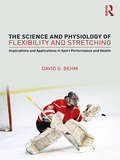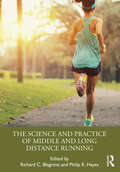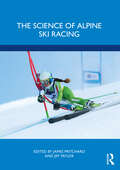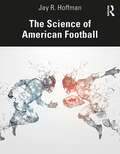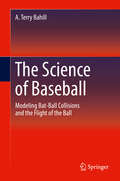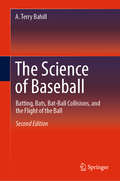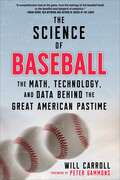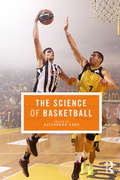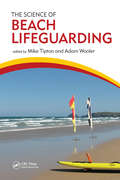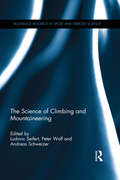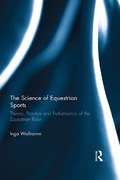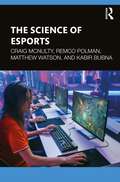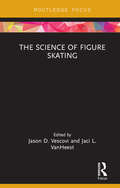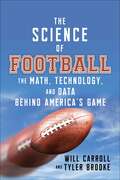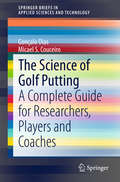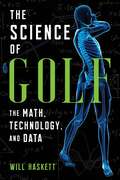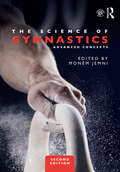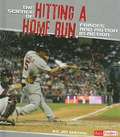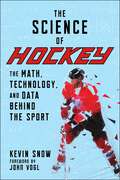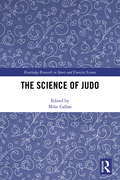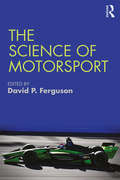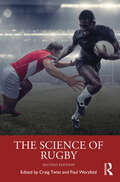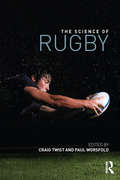- Table View
- List View
The Science and Philosophy of Martial Arts: Exploring the Connections Between the Cognitive, Physical, and Spiritual Aspects of Martial Arts
by Alex W. TongThrough the lenses of Shotokan Karate and biomedicine, sensei and biomedical scientist Alex W. Tong shows readers how body, mind, and spirit can be developed through martial arts practice.Through the practice of martial arts, a person can realize their full potential--not only in body, but in mind and spirit. The Science and Philosophy of Martial Arts shows readers how. Author, sensei, and biomedical scientist Alex W. Tong delves into the physical, mental, and spiritual components of martial arts and integrates contemporary sports psychology, kinesiology, and neuroscience into a nuanced and illuminating understanding of what martial arts practice can be. Structured into three sections, Tong discusses: • The Mind: The dao of martial arts, mental tranquility, contemporary neuroscience, and warming up the brain • The Body: Posture and stance, breathing in martial arts, and the physics of mastery and effort • The Spirit: Soul, spirit, and moving zen; nature and manifestations of the spirit Each section includes observations on martial arts origins, physiology, and tangible results on martial arts training. Blending traditional and contemporary approaches, knowledge, and research, The Science and Philosophy of Martial Arts builds a vision of practice that elevates physical performance, awareness, decisiveness, and strength of spirit.
The Science and Physiology of Flexibility and Stretching: Implications and Applications in Sport Performance and Health
by David BehmThe Science and Physiology of Flexibility and Stretching is the most up-to-date and comprehensive book to cover the underlying physiology and psychology of flexibility enhancing techniques, critically assessing why, when, and how we should stretch, as well as offering a highly illustrated, practical guide to stretching exercises. This fully revised new edition not only updates the present information but adds new chapters on areas that have attracted substantial interest in the last 5 years such as foam rolling, vibration, global effects of stretching, alternative methods to increase flexibility (e.g., resistance training) and others.Richly illustrated, and including an online resource, The Science and Physiology of Flexibility and Stretching provides an important scientific inquiry into stretching as well as other flexibility enhancing techniques (e.g., foam rolling, vibration, resistance training, and others) and an invaluable reference for any strength and conditioning coach or student, personal trainer, sports coach, or exercise scientist.
The Science and Physiology of Flexibility and Stretching: Implications and Applications in Sport Performance and Health
by David G. BehmStretching is a fundamentally important part of sport and exercise, playing a role in improving performance, and preventing injury and rehabilitation, but its scientific underpinnings have, to this point, been overlooked in book publishing. The Science and Physiology of Flexibility and Stretching is the most up-to-date and comprehensive book to cover the underlying physiology and psychology of stretching, critically assessing why, when, and how we should stretch, as well as offering a highly illustrated, practical guide to stretching exercises. Placing stretching in the context of both health and performance, the first section of the book sets out the science behind stretching, critically assessing the benefits, disadvantages, and roles of different types of stretching, exploring the mechanisms behind increasing range-of-movement through stretching and other methods, and offering evidence-based guidance on building stretching into warm-ups. In its second section, the book provides a step-by-step guide to static, dynamic, and PRF stretching exercises for beginners, through recreational athletes, to elite performers. Richly illustrated, and including an online resource, The Science and Physiology of Flexibility and Stretching provides an important scientific enquiry into stretching, and an invaluable reference for any strength and conditioning coach or student, personal trainer, sports coach, or exercise scientist.
The Science and Practice of Middle and Long Distance Running
by Richard C. Blagrove; Philip R. HayesThe popularity of distance running as a sport, and a recreational activity, is at an all-time high. Motivated by the desire to achieve a personal best, remain healthy, or simply complete an event, distance runners of all ages and abilities actively seek out advice from experienced coaches and sport scientists. This is also reflected in the growth of programmes of education for young coaches and aspiring sport scientists in recent years. There are a multitude of different approaches to training distance runners; however, the basic principles and ingredients required for success are applicable to any distance runner. The science that underpins the training and physical preparation of distance runners has developed considerably in recent years. The most experienced and successful coaches in the distance running community rarely have the opportunity to share their tried and tested methods of training. Similarly, the novel work of sport scientists is often only accessible to elite runners, their support teams and academia. The Science and Practice of Middle and Long Distance Running links together the science and coaching artistry associated with preparing distance runners for events ranging from 800 m up to ultra-marathon distances. It combines the latest scientific evidence, published by world-leading sport scientists, with the sound training principles and strategies adopted by experienced coaches. The book translates cutting-edge scientific research from the fields of physiology, biomechanics, psychology and nutrition into practical suggestions for achieving success. Important topical issues and contemporary practices related to health and performance are also addressed. This book is an essential addition to the library of any distance runner, coach or sport scientist.
The Science of Alpine Ski Racing
by Jim Taylor James PritchardAlpine skiing or downhill skiing is defined by six disciplines: Downhill, Super G, Giant Slalom, Slalom, Parallel, and Combined that test the athletes’ technical abilities and speed. It has long been a popular sport with many national and international championships and is a mainstay of the Winter Olympic Games. The Science of Alpine Ski Racing is the first book to discuss the science, coaching, research, and training of elite to recreational alpine ski racers for optimal performance. This book brings together the complex physiological, biomechanical, and technical components of the sport in a practical manner with which coaches and researchers alike can adopt to elicit better performance outcomes for athletes. Literature of this kind has never been formally researched and published specifically for the sport of alpine ski racing making it both unique and a cornerstone to the discipline. Backed by cutting-edge research, the book provides practical guidance on preparing athletes for high performance and understanding the core tenets of sports science underpinning it striking a balance between the complex theoretical and practical components coaches and athletes must prepare for in alpine ski racing. Accessibly written and featuring contributions from world-leading experts, The Science of Alpine Ski Racing covers key topics of health, training, and high performance in the sport and will be vital reading for youth coaches, professional ski instructors, strength and conditioning coaches, and sports science staff associated with winter sports programs as well as applied researchers looking for a model to apply to other sports. James (Jimmy) Pritchard is a human performance specialist/sports scientist who has trained and consulted athletes at the Olympic, NHL, NFL, and Division I collegiate level. Specific to alpine ski racing, he served as the Director of Strength and Conditioning for Ski and Snowboard Club Vail in Vail, Colorado where he helped prepare a long list of US Ski Team athletes including Alice McKennis, Mikaela Shiffrin, and Tess Johnson. He is a certified strength and conditioning specialist (CSCS) as well as registered strength and conditioning coach (RSCC) through the NSCA working with athletes and human performance program managers on a regular basis to find optimal human performance solutions. James has presented at conferences around the United States discussing long term athlete development, written over 150 articles for several media outlets, has been published in the NSCA’s Strength and Conditioning Journal, and taught courses about strength and conditioning at Colorado Mountain College. James holds a BSc in Exercise Science from Colorado Mesa University and MSc degree in Exercise Science from Edith Cowan University. Jim Taylor, PhD, Psychology, is an internationally recognized authority on the psychology of sport and parenting. He has consulted with athletes, coaches, and parents in tennis, skiing, cycling, triathlon, track and field, swimming, football, golf, baseball, fencing, and many other sports for more than 30 years. Dr. Taylor is the author of 17 books and the editor of 4 textbooks on sport psychology. He is also a former world-ranked alpine ski racer, second-degree black belt in karate, marathon runner, and Ironman triathlete.
The Science of American Football
by Jay R. HoffmanThe game of American football may be the greatest team sport that exists. It epitomizes the need of a "team" first approach to achieve the desired success. Success is often measured as the hoisting of a championship trophy, which involved a journey that required discipline, perseverance, sacrifice, and hard work. These traits are the backbone of success in football, but more importantly they are the backbone or blueprint for success in life. The Science of American Football provides an in-depth discussion on the physiology of the game of American football, including the physiological strain associated with playing in various environmental extremes. Acclimatization, preparation, and medical issues associated with each of these environmental extremes are discussed as well as medical issues occurring during the athlete’s playing career (common sites of injury) and potential risks arising post-career (e.g. neurological dysfunction, arthritic joints, obesity). The book goes on to consider aspects of player selection and preparation, including discussion of evidence-based physical conditioning programs, appropriate nutrition, and specific dietary supplementation for the American football player. The Science of American Football is the first book to focus on the physiology, science, and medical issues associated with the game of American football and will be key reading for students of coaching and exercise science as well as those with a keen interest in understanding the science of American football, such as coaches and players.
The Science of Baseball
by A. Terry BahillThis book describes the dynamic collisions between baseballs, softballs, and bats, and the intricate modeling of these interactions, using only Newton’s basic principles and the conservation laws of physics. Veteran baseball science author Terry Bahill explains models for the speed and spin of balls and bats and equations for bat-ball collisions at a level accessible to high school and undergraduate physics students, engineering students, and, most importantly, students of the science of baseball. Unlike other, more technical accounts of these phenomena that exhibit similar rigor, the models presented in this volume use only basic physical principles to describe simple collision configurations. Elucidating the most important factors for understanding bat performance—bat weight, moment of inertia, the coefficient of restitution, and characteristics of humans swinging the bats, Dr. Bahill also explains physical aspects of the ideal bat and the sweet spot.• Explains how to select or design an optimal baseball or softball bat and create models for bat-ball collisions using only fundamental principles of mechanics from high school physics;• Describes the results of the collision between baseball and bat using basic mathematics such as equations for the speed of the ball after the collision, bat speed after the collision, and bat rotation after the collision;•Accessible to high school and undergraduate students as well as non-technical aficionados of the science of baseball. “Dr. Bahill’s book is the perfect tool for teaching how to solve some of baseball’s basic science problems. Using only simple Newtonian principles and the conservation laws, Dr. Bahill explains how to model bat-ball collisions. Also, he derives equations governing the flight of the ball, and proceeds to show what factors affect air density and how this density affects the ball’s flight. And as a unique addition to his fine book, he provides advice for selecting the optimal bat—a surprising bonus!”Dave Baldwin, PhDMajor League pitcher, 1966-1973, lifetime Major League ERA, 3.08 “If I were the General Manger of a baseball team, I would tell my people to write a ten-page paper describing what this book contains that could improve our performance. I think the book provides the foundation for change.”Bruce GissingExecutive VP-Operations (retired) Boeing Commercial Airplanes“[I] had a chance to read your research, and I fully agree with your findings.”Baseball Legend Ted Williams, in a 1984 letter to the author
The Science of Baseball: Batting, Bats, Bat-Ball Collisions, and the Flight of the Ball
by A. Terry BahillThis augmented, new edition adds discussion of the bat’s vertical sweetness gradient, eye-hand cross-dominance, models for the swing of a bat, and accuracy of simulations. The book retains its description of dynamic collisions between baseballs, softballs, and bats, and the intricate modeling of these interactions, using only basic math and physical principles. Veteran baseball science author Terry Bahill explains models for the speed and spin of balls and bats and calculations for bat-ball collisions at a level accessible to most students of the science of baseball. Demystifying the most important factors for understanding bat performance—bat weight, moment of inertia, the coefficient of restitution, and characteristics of humans swinging the bats—Dr. Bahill also explains physical aspects of the optimal bat and the sweet spot.Praise for the First Edition “Dr. Bahill’s book is the perfect tool for teaching how to solve some of baseball’s basic science problems. Using only simple Newtonian principles and the conservation laws, Dr. Bahill explains how to model bat-ball collisions. Also, he derives equations governing the flight of the ball, and proceeds to show what factors affect air density and how this density affects the ball’s flight. And as a unique addition to his fine book, he provides advice for selecting the optimal bat—a surprising bonus!”Dave Baldwin, PhDMajor League pitcher, 1966-1973, lifetime Major League ERA, 3.08 “If I were the General Manger of a baseball team, I would tell my people to write a ten-page paper describing what this book contains that could improve our performance. I think the book provides the foundation for change.”Bruce GissingExecutive VP-Operations (retired) Boeing Commercial Airplanes“[I] had a chance to read your research, and I fully agree with your findings.”Baseball Legend Ted Williams, in a 1984 letter to the author
The Science of Baseball: The Math, Technology, and Data Behind the Great American Pastime
by Will CarrollIn The Science of Baseball, sportswriter and injury expert Will Carroll shows how understanding the science behind the Great American Pastime helps fans appreciate its nuances and that it enhances, not detracts from the greatest game ever invented. Carroll, as well as several experts via interviews, covers topics like what makes the ball break, bounce, and fly; how material science and physics work together to make the bat function; how hitters use physics, geometry, and force to connect; sensors and cameras; injuries; and much more. Baseball aficionados and science geeks alike will better appreciate the game--no matter which teams are playing--after reading this comprehensive book!
The Science of Basketball
by Alexandru RaduThe Science of Basketball is the only book to examine the scientific principles underpinning preparation and performance in basketball, applied to both individual and team contexts. Drawing on the very latest scientific evidence, and including contributions from leading international coaches and scientists involved in the sport, the book explores every aspect of physical and mental preparation and performance, including: strength and conditioning, and training strategies physiological aspects of performance nutrition and supplementation psychological preparation skill acquisition biomechanical aspects of performance performance analysis injury epidemiology, prevention and rehabilitation coach education Incorporating case studies at the end of each chapter to demonstrate how scientific principles can be applied to practice, the book bridges the gap between theory and applied practice in basketball better than any other. It is essential reading for any student, researcher, sport scientist, coach, physiotherapist or clinician with an interest in the game, and illuminative supplementary reading for students of sport science and sports coaching.
The Science of Beach Lifeguarding
by Mike Tipton Adam WoolerThe World Health Organization’s recently published Global Report on Drowning found that drowning is the third leading cause of unintentional injury death worldwide—making the information presented in this new book an important part of the global effort to reduce this health risk.Written by leading researchers and academics from around the world, The Science of Beach Lifeguarding focuses on the scientific evidence that underpins what is taught to and practised by beach lifeguards. It is the first book to pull together all the different areas involved in beach lifeguarding and evaluate their evidence base.An accessible and informative reference underpinned by the best current research, the book’s key themes cover the context of beach lifeguarding, the physical environment in which lifeguards work, medical aspects, practical lifeguarding techniques, physiological standards for lifeguards, safety education, and future developments in beach lifeguarding.The book presents groundbreaking work quantifying the scientific rationale behind a universally accepted fitness standard. It supplies an in-depth examination of the risks and hazards associated with the beach environment, including rip currents and cold water immersion.The book includes a state-of-the-art review of drowning and a comprehensive chapter on first aid. Detailing the recently announced 2015 European Resuscitation Council Guidelines, this book is a must-have for beach lifeguards, beach lifeguard managers, search and rescue personnel, paramedics, sports scientists, health and safety practitioners, and occupational health practitioners.
The Science of Climbing and Mountaineering (Routledge Research in Sport and Exercise Science)
by Ludovic Seifert Peter Wolf Andreas SchweizerThis is the first book to explore in depth the science of climbing and mountaineering. Written by a team of leading international sport scientists, clinicians and climbing practitioners, it covers the full span of technical disciplines, including rock climbing, ice climbing, indoor climbing and mountaineering, across all scientific fields from physiology and biomechanics to history, psychology, medicine, motor control, skill acquisition, and engineering. Striking a balance between theory and practice, this uniquely interdisciplinary study provides practical examples and illustrative data to demonstrate the strategies that can be adopted to promote safety, best practice, injury prevention, recovery and mental preparation. Divided into six parts, the book covers all essential aspects of the culture and science of climbing and mountaineering, including: physiology and medicine biomechanics motor control and learning psychology equipment and technology. Showcasing the latest cutting-edge research and demonstrating how science translates into practice, The Science of Climbing and Mountaineering is essential reading for all advanced students and researchers of sport science, biomechanics and skill acquisition, as well as all active climbers and adventure sport coaches.
The Science of Equestrian Sports: Theory, Practice and Performance of the Equestrian Rider
by Inga WolframmThe Science of Equestrian Sports is a comprehensive study of the theory and practice of the rider in equine sport. While most scholarship to date has focused on the horse in competition, this is the first book to collate current data relating specifically to riders. It provides valuable insight into improving sporting performance and maintaining the safety of both the horse and the rider. Drawing on the latest scientific research, and covering a wide range of equestrian disciplines from horseracing to eventing, the book systematically explores core subjects such as: physiology of the rider sport psychology in equestrian sport preventing injury biomechanics and kinematics coaching equestrian sport the nature of horse-rider relationships This holistic and scientific examination of the role of the horse rider is essential reading for sport science students with an interest in equestrian sport and equitation. Furthermore, it will be an invaluable resource for instructors, coaches, sport psychologists, or physiologists working with equestrian athletes.
The Science of Esports
by Matthew Watson Craig McNulty Remco Polman Kabir BubnaThe Science of Esports draws from contemporary research and coach expertise to examine esports athlete health and performance from a range of disciplinary perspectives, including physiology, psychology, sociology, and nutrition. The rapid expansion of the esports industry has elevated competitive video gaming into the realm of high performance, requiring players, coaches, and practitioners to implement interdisciplinary approaches to performance support. The book covers key topic areas such as: What esports is and similarities and differences to sport Game-specific training Physiological and psychological consideration for esports athletes Social aspects of player performance and the social environment of esports Esports coaching and structure of esports performance environments Technology and its use in esports Safeguarding, cheating, and gambling This book includes worked examples and case studies to allow immediate implementation into practice for esports athletes and coaches. It summarises the current state of research to inform researchers and identify gaps in knowledge. This book is critical reading for students of esports and related courses. It serves as the first scientific resource designed to provide athletes, coaches, and practitioners with interdisciplinary insights into esports health and performance.
The Science of Figure Skating (Routledge Research in Sport and Exercise Science)
by Jason D. Vescovi Jaci L. VanHeestThe Science of Figure Skating is the first book to provide an evidence-based and comprehensive reference for the scientific underpinnings of this complex Olympic sport, where early specialization presents unique challenges for coaches and athletes alike. Drawing on cutting-edge research and featuring contributions from leading academics and practitioners, the book covers key topics of health, training and high performance in figure skating, including: Physiological demands Nutrition and hydration Training methods Psychology and mental performance Novel issues relating to performance such as travel and jet lag Technological innovation Effectively and succinctly applying theory to practice, The Science of Figure Skating is a valuable resource on integrating sport science concepts into training and performance. It is essential reading for any applied sport science student or researcher with an interest in winter sports, and coaches, sport science officers, nutritionists or clinicians involved in figure skating.
The Science of Football: The Math, Technology, and Data Behind America's Game
by Will Carroll Tyler BrookeInThe Science of Football, sportswriter and injury expert Will Carroll teams up with writer and podcast host Tyler Brooke to show how understanding the science behind American football helps fans appreciate the sport even more. The authors cover topics like injuries, equipment, and analytics from all sides of the game, including offense, defense, and special teams. After reading this fascinating addition to the successful Science of series, football enthusiasts at the professional, college, and high school levels and science geeks alike will better appreciate the game--no matter which teams are playing!
The Science of Golf Putting
by Gonçalo Dias Micael S. CouceiroThis SpringerBrief explores the motor performance and biomechanics of golf putting, providing methodologies, studies and approaches to this concept. Presenting outcomes of research published over the past six years, it offers guidelines from a scientifically oriented perspective, and employs new technologies and mathematical methods to assess golf putting. The chapters cover aspects such as pendulum-like motion in sports, setting up the experimental design, and performance metrics for putting variables. Paving the way for an improved understanding of what leads to failure and success in golf putting, this book offers an invaluable reference source for sports scientists, engineers and mathematicians, as well as golfers.
The Science of Golf: The Math, Technology, and Data
by Will HaskettThe perfect gift for golf enthusiasts of all experience levels! InThe Science of Golf, seasoned sports broadcaster Will Haskett examines the science behind the beloved sport of golf. The author covers topics like the swing, the body, the mind, the equipment, the agronomy of the course, analytics, and much more. Haskett explains what makes the ball fly, how different swings can accomplish the same result, why different playing fields impact each shot, and how a rapid improvement in technology has made the sport easier and more accessible. With insight from industry experts, sports scientists, and some of golf&’s best minds, this book may surprise golf gurus and science geeks alike!
The Science of Gymnastics: Advanced Concepts
by Monèm JemniThe Science of Gymnastics provides the most comprehensive and accessible introduction available to the fundamental physiological, biomechanical and psychological principles underpinning performance in artistic gymnastics. The second edition introduces three new sections: applied coaching, motor learning and injury prevention and safety, and features contributions from leading international sport scientists and gymnastics coaches and instructors. With case studies and review questions included in each chapter, the book examines every key aspect of gymnastic training and performance, including: physiological assessment diet and nutrition energetics kinetics and kinematics spatial orientation and motor control career transitions mental skills training and perception injury assessment and prevention, with clinical cases advanced case studies in rotations, vault approach and elastic technologies in gymnastics. A fully dedicated website provides a complete set of lecture material, including ready-to-use animated slides related to each chapter, and the answers to all review questions in the book. The book represents an important link between scientific theory and performance. As such, The Science of Gymnastics is essential reading for any student, researcher or coach with an interest in gymnastics, and useful applied reading for any student of sport science or sports coaching.
The Science of Hitting a Home Run: Forces And Motion In Action (Action Science Ser.)
by Jim WhitingDescribes the science behind hitting a home run, including pitch types, different bats, and force
The Science of Hockey: The Math, Technology, and Data Behind the Sport
by Kevin SnowWhether you&’re a casual hockey observer or a passionate fan who can&’t get enough of the game, there&’s something for everyone in The Science of Hockey. Author Kevin Snow spoke with former players and coaches, along with numerous industry experts and media analysts to discover how science, data, and technology have impacted the sport of hockey over the years. Learn more about the nuances of a skating stride, how a puck is manufactured, the optimal temperature for making ice, and what exactly it is that makes some of the greatest players in the world so special. Even take a look to the future to find out how virtual reality can play a part in player training methods. Just when you thought you knew it all, along comes The Science of Hockey to share even more knowledge about the coolest game on ice.
The Science of Judo (Routledge Research in Sport and Exercise Science)
by Mike CallanThe Science of Judo is the first book to set out and discuss the science, coaching and history behind judo performance. Evidence-based and informed by the latest research, the book offers practical guidance on preparing athletes for high performance and understanding the core tenets of sport science underpinning it. Featuring contributions from world-leading experts, the book consists of chapters on all aspects of judo performance, including: The historical development of judo and its physical, intellectual and moral role Physical preparation for competition, coaching and training strategies Skill acquisition, talent identification and development Nutrition and lifestyle of judoka Performance analysis and biomechanics Injury epidemiology and prevention Special considerations for female and young judoka Clearly written and accessible, The Science of Judo provides upper-level students and researchers, and coaches and sport science staff working with judoka, with the most thorough and authoritative reference on sport science applied to judo currently available.
The Science of Motorsport
by David P. FergusonDespite its worldwide following, high levels of investment and scientific complexity, there is a lack of evidence-based literature on the science of human performance in motorsport. Focusing on the physiological, psychological and sport medicine aspects of training, performance, injury and safety, The Science of Motorsport is the first book to provide an accessible and up-to-date resource for stakeholders at all levels of motorsport. <P><P>Addressing the physiological and psychological stresses of racing across a full range of sports, from Formula 1 and IndyCar to NASCAR and endurance racing, the book includes chapters on: <li> nutritional and physical training strategies for drivers; <li>the driver’s neck; <li> injury rates and pathologies of open-wheel driving; <li> return to competition from concussion; <li> driver safety; <li> and considerations for pit crews and safety staff. <P><P>Accessibly written and made up of contributions from world-leading authorities in motorsport science research, this is a crucial resource for racing drivers, physical trainers, pit crew members and safety personnel, as well as researchers and students with an interest in applied sport physiology, applied sport psychology or sport medicine.
The Science of Rugby
by Craig Twist Paul WorsfoldCoaches, practitioners and medical staff working in the worldwide sport of rugby will frequently apply scientific principles to their programmes to inform the practice, performance, health, well-being and development of their athletes. This book explores the scientific principles underpinning the preparation and management of rugby players in both codes and modified versions of the sport. Applied examples are also provided throughout to understand the practical application of the material in a real-world context. This new edition of The Science of Rugby offers a significant contribution to the field of rugby science that will act as a useful resource to scientists, coaches, practitioners and students interested in rugby. New chapters and key topics include: • Physical and psychological preparation for rugby • Planning and monitoring of training • Managing fatigue, recovery and nutrition • Effects of different environmental conditions and travel on performance • The mechanics of rugby techniques and injury • Young players and talent identification • Considerations for training the female rugby player • Modified rugby, including rugby sevens, touch, tag and wheelchair rugby No other book bridges the gap between theory and applied practice in rugby, from grass roots to elite international standard, and therefore this is essential reading for any student, researcher, sport scientist, coach, physiotherapist or clinician with an interest in the game.
The Science of Rugby ("English Labouring-Class Poets, 1700–1900")
by Craig Twist Paul WorsfoldThe Science of Rugby is the only book to examine the scientific principles underpinning the preparation of rugby players for high performance. Drawing on the very latest scientific evidence, and covering both codes (union and league), the book explores every aspect of preparation and performance that introduces best practice by leading coaches and sports science professionals from around the rugby world. The book covers key topics such as: Physical preparation and conditioning Strength and power training Monitoring match and training demands Match-day strategies for enhancing physical and technical performance Management of fatigue and recovery Training and playing in the heat Travel and jet lag Injury epidemiology Psychological preparation Performance analysis Biomechanics Nutrition Talent identification and youth development The book also incorporates several case-studies to demonstrate how scientific principles have been applied in practice. No other book bridges the gap between theory and applied practice in rugby, from grass roots to elite international standard, and therefore this is essential reading for any student, researcher, sport scientist, coach, physiotherapist or clinician with an interest in the game.
